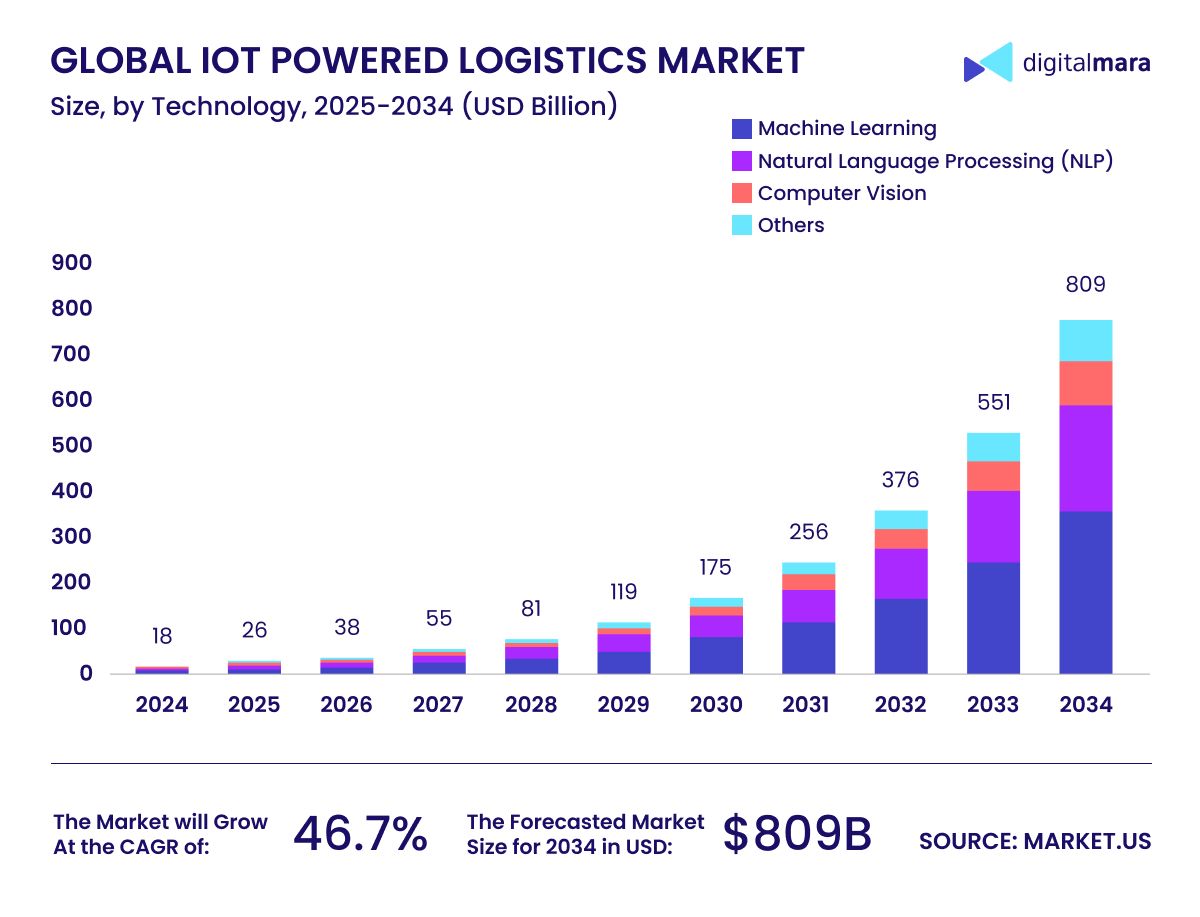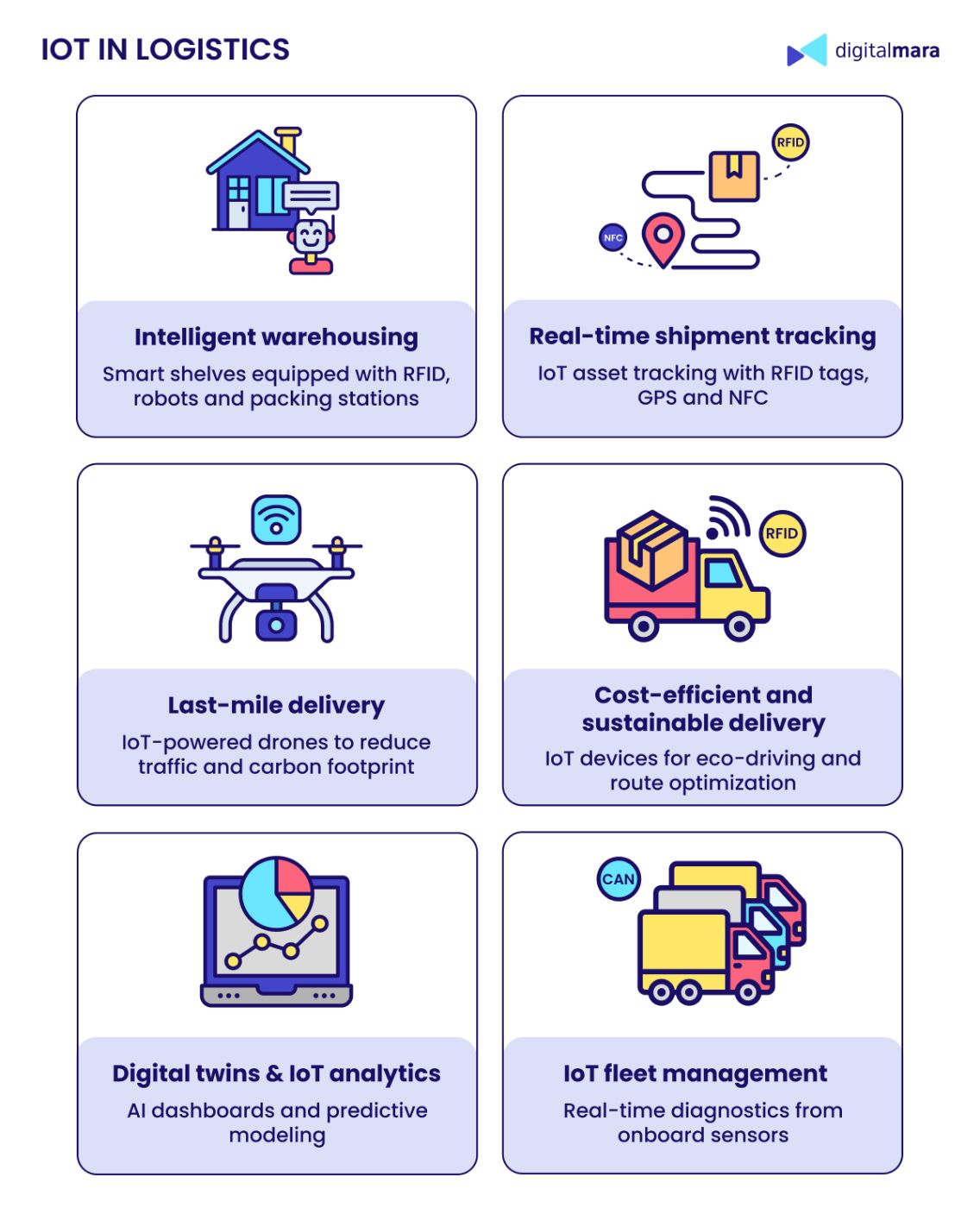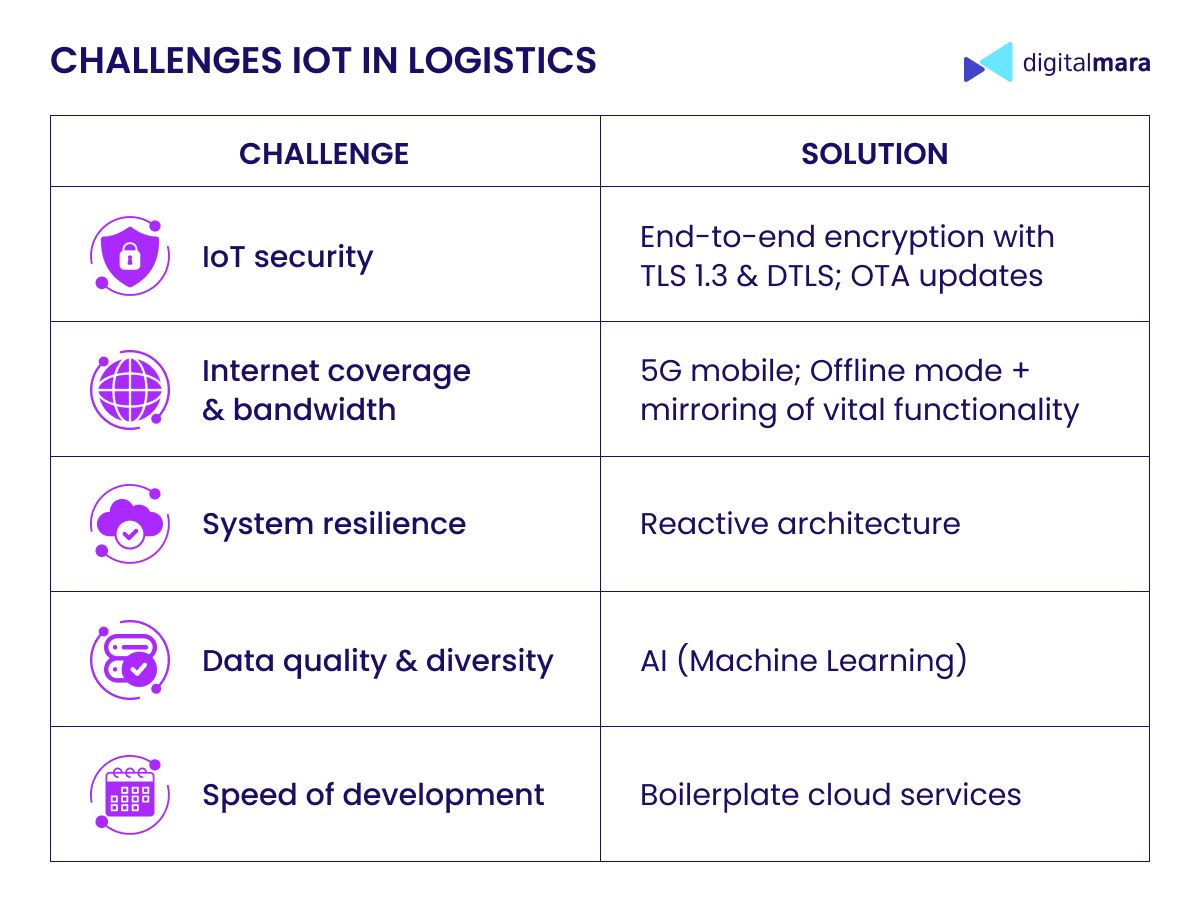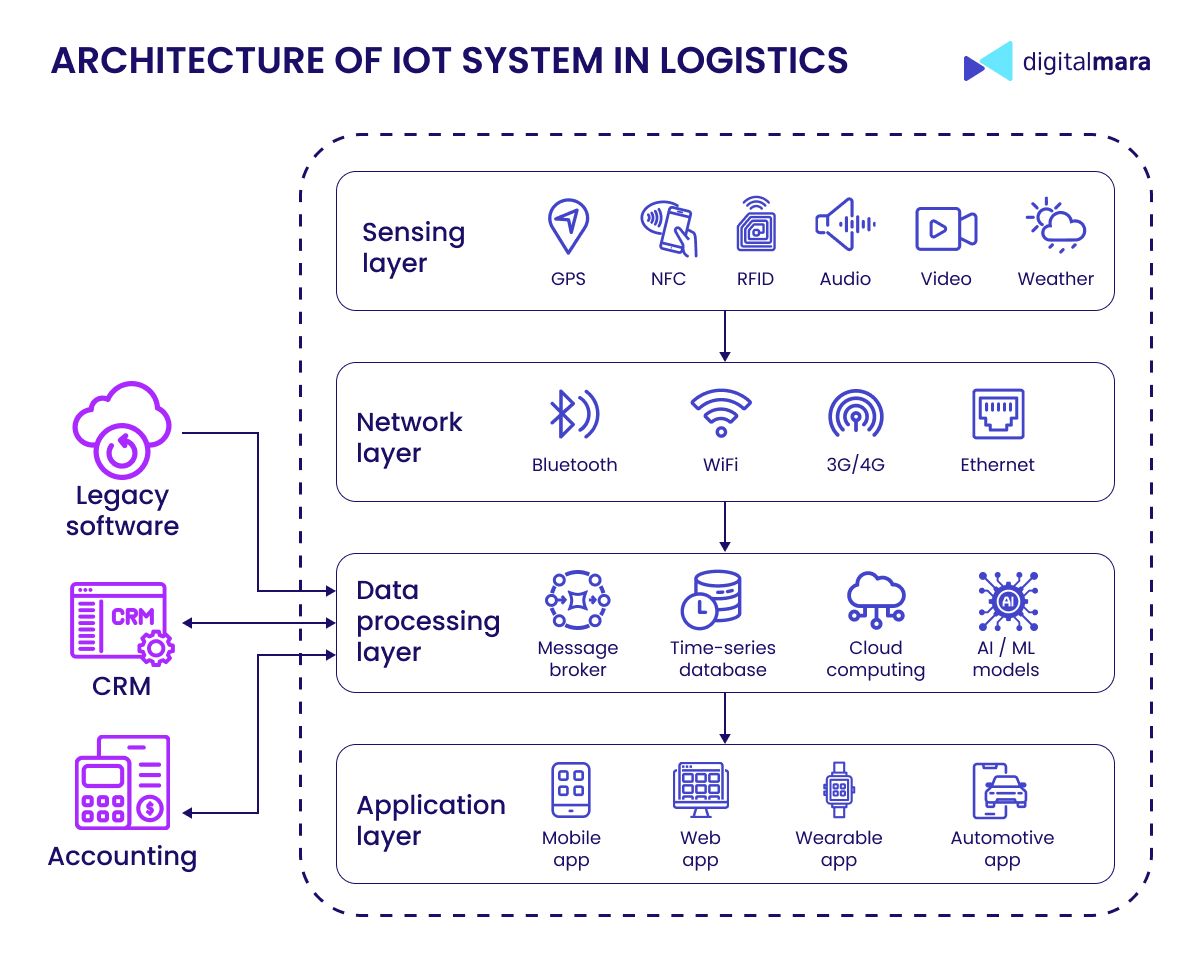This content originally appeared on HackerNoon and was authored by DigitalMara
The Internet of Things is no longer a newcomer in the field of cargo delivery, but the rise of Artificial Intelligence has taken these systems to a whole new level. Smart logistics solutions now connect previously separate elements into one ecosystem, improving service quality and giving end customers a much better experience. This combo of IoT and logistics also helps companies tackle key costs such as fuel, driver wages, equipment wear and tear, and fines for undelivered shipments. With intelligent devices, companies can optimize their routes, monitor vehicle health in real time, and avoid delays. Plus, it’s a win for the planet — a more efficient IoT supply chain means fewer emissions, less waste, and better sustainability overall.
According to market.us, global spending on IoT in logistics hit USD 17.5 billion in 2024 and is expected to grow to USD 809 billion by 2034.

So, what makes this technology so valuable? In this article from DigitalMara, we’ll explore the main benefits and where they’re already making a difference.
The power of IoT in Logistics and Supply chain management
To be honest, logistics isn’t the most scintillating topic. But throw in the Internet of Things (IoT), mix it with AI, and suddenly you’ve got some intriguing concepts: smart trucks, intelligent warehouses, and even self-aware packages that know more about delivery than your intern does. No more guesswork for your team — they’ll receive instant updates on shipments and inventory levels, right when they need them.
IoT is revolutionizing logistics across several core areas. Let's dive deeper into them.

Real-time shipment tracking
Would you like to worry less about where your package is? IoT asset tracking gives you full visibility into your cargo in real time. It starts with GPS modules, RFID tags that identify individual items, and a variety of environmental sensors attached directly to the goods. These devices can monitor temperature, humidity, shocks, tilts, and any unauthorized access along the way.
All sensor data travels wirelessly to cloud-based platforms, where it’s processed and displayed in clean, easy-to-use dashboards. That gives your logistics team instant access to everything they need to know — anytime, from anywhere. Moreover, thanks to IoT security features, if a shipment enters or exits a restricted zone or gets jolted too hard, or someone tries to open it without permission, alerts will go straight to your control center.
Cost-efficient and sustainable delivery
Route optimization isn’t just about the shortest path — road quality, speed limits, meteorological conditions, and construction all affect delivery times and costs. That’s where IoT devices in logistics prove their value. They collect data not only from vehicle sensors but also from external sources such as traffic and weather. AI systems then use this information to adjust routes on the fly, helping to avoid delays and costly detours. This means less wasted fuel, reduced driver overtime, and smarter scheduling — all helping to cut delivery expenses. Plus, IoT software can detect inefficient driving habits, like speeding or harsh braking, to prevent accidents caused by fatigue or bad weather, saving on insurance and repair costs. Eco-driving is another big benefit, reducing emissions and boosting sustainability.
Another area where automation can pay off is last-mile delivery. This is often the most challenging and expensive part of the journey. IoT-powered drones and autonomous vehicles can navigate complex urban streets with their crowded neighborhoods, increasing delivery pace and lowering costs. This tech not only improves speed and accuracy but also reduces traffic congestion and carbon footprint, contributing to greener shipments.
IoT fleet management
With smart fleet tech powered by IoT, you're not just tracking where your vehicles are, you're keeping tabs on how they’re holding up under the hood. Real-time diagnostics from onboard sensors monitor everything from engine performance and brake wear to tire pressure and battery health. It’s like having a virtual mechanic riding shotgun in every truck.
Additionally, the IoT analytics break down what caused any extra wear: maybe rough roads, maybe your driver’s heavy foot on the brakes. AI predictive maintenance tools step in before problems do, flagging issues early and suggesting which spare parts to stock up on. That means fewer breakdowns, smarter repairs, and no more last-minute parts runs.
So maybe your fleet will get even smarter in the future and say, “Thanks for not waiting until I’m coughing smoke to check my oil.” Who knows?
Intelligent warehousing and IoT inventory management
You can’t imagine modern logistics without digital warehousing. Smart shelves equipped with RFID and IoT devices track inventory in real time, taking the guesswork out of stock levels and item locations. In an advanced AI warehouse, these sensors team up with robots and packing stations to quickly adapt to changing products and volumes, cutting errors and speeding up processing. Many of these systems are already running in major distribution centers like Amazon.
Also worth mentioning is the latest innovation of smart packaging, which communicates directly with customers via their smartphone to update delivery status, offer storage tips, or even initiate returns and recycling. This is mostly done today using QR codes or NFC tags. However, we can expect more advanced features soon, like dynamic environmental sensing to monitor freshness or damage, automated reorder triggers, and AI-powered customer engagement through the packaging itself.
Maybe someday smart packaging will monitor how many bags of chips you’ve got in your cart—and gently encourage you to choose healthier snacks instead!
Addressing the challenges of IoT in Transportation and Logistics
Applications of IoT logistics involve generating tons of data and devices chatting nonstop. That brings real challenges, but tech is stepping up to keep things smooth, safe, and reliable. Let’s check out the biggest hurdles and how they’re being solved.

IoT security: keeping data safe from start to finish
Security is a major concern in IoT logistics, both for the devices and the data they send. Many of these units have limited power and outdated software, making them vulnerable. Data also travels across networks that hackers can target. End-to-end encryption with protocols like TLS 1.3 and DTLS helps protect communications, while OTA (Over-The-Air) updates ensure devices remain current. With the help of OTA, providers can remotely send software fixes over wi-fi, cellular, or 5G connections, keeping equipment secure and running smoothly without any downtime.
Internet coverage & bandwidth: 5G to the rescue
IoT in logistics depends heavily on reliable connectivity. However, coverage gaps and limited bandwidth often slow down real-time data transfer, especially in remote areas or busy urban hubs. That’s where 5G mobile technology comes into play. With its blazing-fast speeds, massive device capacity, and low latency, 5G promises consistent, seamless connections to keep sensors, trackers, and devices perfectly in sync.
Beyond that, it is wise to implement at least a partial offline mode and mirror vital functionality on the devices at every point. When the internet connection is restored, the collected data can then be transferred to the central system, while outdated data will be refreshed.
System resilience & data sync: going reactive
One big challenge is keeping everything running smoothly, even when there are delays in data from sensors or certain parts of the system experience disruptions. The answer lies in building the system using a reactive architecture. This approach assumes from the start that things might go wrong — networks might lag, devices might go offline — so the software is built to stay responsive, flexible, and resilient. These systems can handle data spikes without breaking a sweat, process updates in real time, and recover gracefully from failures. As a result, logistics platforms stay robust enough to keep operations running smoothly.
Data quality & diversity: let AI sort it out
Sensors come in all shapes and sizes — GPS modules, temperature sensors, accelerometers, RFID readers — and the data they produce can vary widely in format and quality. Cleaning, normalizing, and making sense of all this heterogeneous data is no small feat. That’s where AI in logistics really saves the day. Machine learning cuts through the noise, spots odd patterns, and even sniffs out problems before they blow up. This not only boosts accuracy but also helps optimize routes, inventory, and maintenance schedules based on real, high-quality insights.
Speed of development: cloud power & modularity
Time to market is crucial in logistics. To stay competitive, many teams rely on boilerplate cloud services like Microsoft Azure, which offer ready-made building blocks for IoT projects. These platforms enable faster development, easy scaling, and smoother transitions from prototype to production. For example:
- Azure IoT Hub acts as a central hub for secure, reliable device-to-cloud and cloud-to-device communication, managing millions of IoT devices.
- Azure IoT Central is a managed IoT platform with logistics templates like asset tracking and cold chain, offering device templates, dashboards, alerts, APIs, and Power BI integration.
- Azure Digital Twins lets you model real-world logistics environments and relationships between assets like trucks and warehouses for better insights.
- Azure Maps provides location services such as geofencing, route optimization, and weather data to improve delivery accuracy.
- Azure Time Series Insights Gen2 analyzes sensor data trends in real time, making it ideal for monitoring cold chains and predictive maintenance.
Other notable services include Azure Machine Learning for demand forecasting and delivery prediction; Azure Synapse Analytics for advanced supply chain reporting; Azure Sphere for securing IoT devices; and Microsoft Defender for IoT for network and device security.IoT is revolutionizing logistics across several core areas. Real-time shipment tracking gives you full visibility into your cargo in real time. IoT-powered drones and autonomous vehicles can navigate complex urban streets with their neighborhoods.
Why custom software development wins the day
When it comes to smart logistics solutions, off-the-shelf software often just doesn’t cut it. Logistics operations can be incredibly diverse — whether you’re moving cargo by land, air, or sea — so a one-size-fits-all system can become more of a roadblock than a solution. That’s where custom development truly comes into its own. Professional developers can tailor everything to fit your exact business workflows, not the other way around.

Need to connect to your existing tools? No problem. A custom logistics app can be integrated seamlessly with your full ecosystem — whether that’s accounting software, CRM systems, or advanced analytics platforms like Tableau — so you keep full visibility and control over your operations. Even better, such an approach won’t disrupt your business. Your legacy software can be smoothly migrated without downtime or major interruptions.
With the rise of IoT devices in logistics, real-time tracking, predictive maintenance, and intelligent automation are more important than ever. Seasoned development companies can design software that works hand-in-hand with these devices, making sense of the data and turning it into actionable insights.
\
This content originally appeared on HackerNoon and was authored by DigitalMara
DigitalMara | Sciencx (2025-08-14T07:41:51+00:00) IoT in Logistics: Efficiency Through Connectivity. Retrieved from https://www.scien.cx/2025/08/14/iot-in-logistics-efficiency-through-connectivity/
Please log in to upload a file.
There are no updates yet.
Click the Upload button above to add an update.
